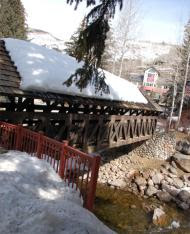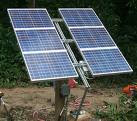 It’s high time for a new Christmas tradition, one in which we’ll joyously deck the roofs with panels of solar or sing Solar Night (Alaskans, get ready!). Could solar-powered LED lighting have saved Grandma from those reindeer? Perhaps not. But it is no less important that we, the solar hosts, proclaim: Even at Christmas time, the sun is king.
It’s high time for a new Christmas tradition, one in which we’ll joyously deck the roofs with panels of solar or sing Solar Night (Alaskans, get ready!). Could solar-powered LED lighting have saved Grandma from those reindeer? Perhaps not. But it is no less important that we, the solar hosts, proclaim: Even at Christmas time, the sun is king.As of yet, there is no solar-integrated Xbox 360, nor Grand Solar Auto to play on it, but that should have no effect on our ability to integrate solar power into this year’s celebrations. After all, home solar is the end-all-be-all of gifts that keep on giving! Solar Claus is coming to town and his bag of goodies is growing like Pinocchio’s nose on Fox News. Fortunately, there’s no red or blue in town this holiday season. This year, it’s all green and yellow and the faint electric shimmer of crystalline silicon.
5 Solar Gifts that Fit Under the Tree
There are hundreds of solar gifts available this Christmas. Every year, the gifts increase and the prices decrease. DIY’ers, outdoorsy types, fashionistas, gadgeteers, readers and businesspeople all have a perfect solar gift waiting for them somewhere, and you won’t need a pot of gold to afford it. A click of the mouse will get any one of these five gifts or a multitude of others.
 Solar Radio. Solar-powered radios are incredibly handy. They’re excellent for camping, spectator sports, long walks, fishing, power failures and other emergencies. The most popular models are wind-up as well, so you are your own backup generator! Price: $30 to $100
Solar Radio. Solar-powered radios are incredibly handy. They’re excellent for camping, spectator sports, long walks, fishing, power failures and other emergencies. The most popular models are wind-up as well, so you are your own backup generator! Price: $30 to $100- Solar Robot Kit. Here’s one for the little scientists among us. Red5’s 6 in 1 Solar Robot Kit is a great solar power exercise for beginners. With only 37 parts, no screws and easy instructions, the whole family will enjoy creating any one of these six forms the little robot can take: moving plane, robotic dog, boat, car, windmill and desktop plane. You get all that for only $20, although it may have to ship from the UK.
- Hybrid Solar Cooker. Open this one early so you can get those potatoes boiling. Solar cookers are available from a range of sellers and are excellent gifts for the solar purist. This Hybrid Solar Cooker is a favorite because it’s reliable in a cloudy pinch and has an excellent portable design. Here’s a solar gift that can make a friend smile on Christmas morning and be feeding that same friend by Christmas night. Price: $299
- Solar Bag or Backpack. Nowadays, you can carry solar power with you. To the subway, to the park, to class, to work or to nowhere. Whichever direction they go, your solar gift recipient will become their own power producer. And their cell phone, MP3 player, e-book or laptop will never die. There are solar purses, solar messenger bags, solar backpacks and even solar laptop bags. Price: $200 to $500
- Solar Bluetooth Speakers. These solar speakers are light, portable and can be connected wirelessly to most cell phones, including the iPhone. The solar panel is integrated to maintain a sleek design and comes with a connector cable so they can be used with non-Bluetooth devices (i.e. iPods and other MP3 players). Price: $79.99 each
Not found in our five highlighted solar gifts are such classics as handheld solar chargers, solar flashlights or lanterns, portable solar kits and any number of other solar gifts. The sky is the limit in solar gifting potential, and the sky is limitless.
Now to expand our limits here on earth, we move into other gifting realms. For it is easy to celebrate a Green Christmas with or without adding solar power to the mix, although that is our most favorite way to do it.
Hooking Up Your Solar Christmas Display
Christmas isn’t all about giving and receiving. It’s also about showing off your holiday spirit. This usually entails hundreds of tiny light bulbs strung all over the house, brightly decorated Christmas trees, wreaths, snowmen and rosy-cheeked, round-bellied lawn ornaments.
Unfortunately, there is a dark side to all this brightness: the insane amount of electricity consumed by the festivities. And yet, there is a bright side as well. We call it solar power, which itself has awesome potential. Take as an example a tunnel at the Toki no Sumika Resort in Japan. It boasts a winter display of 3.2 million lights running through the tunnel. It’s enough to make an eco-conscious tourist’s jaw drop in awe, and then, moments later, their stomach cringe at the thought of grandiose power wasting. But hold your cringes because the entire mesmerizing 3.2-million light display is solar-powered.
Take as an example a tunnel at the Toki no Sumika Resort in Japan. It boasts a winter display of 3.2 million lights running through the tunnel. It’s enough to make an eco-conscious tourist’s jaw drop in awe, and then, moments later, their stomach cringe at the thought of grandiose power wasting. But hold your cringes because the entire mesmerizing 3.2-million light display is solar-powered.
And you can bring that solar power home to your Christmas lighting display as well. Solar-powered string or net lights are now widely available and affordable. They install just like any other string of lights, except for the solar panel, which should be positioned in a place to capture maximum sunlight during the day. The resulting solar electricity is stored, and at night, when integrated sensors detect darkness, the lights kick on. Solar Christmas lights are sold at a wide variety of outlets. Find them online through retailers like Amazon, Solar Illuminations, Solar Santa and even on store shelves.
In addition to solar string lights, you can find solar wreaths, solar garlands, solar tree lights and lanterns, and even some solar lawn ornaments like the penguins and bears available from Solar Santa. If you’d like Santa and his reindeer well-lit and frozen on your front lawn this year, it’s going to take a bit more power than today’s integrated solar lighting can handle. You can always manage a true Solar Santa, however, with some solar power panels on your roof. An always-handy solar generator might do the trick as well.
Extravagant, garish lighting displays are a fundamental part of our Christmas experience. Lucky for us, and our January electric bill, there is nothing the sun does better than create light. Light, which, thanks to solar power, the sun can now give at night as well.
Here’s to a very Green Christmas!


















